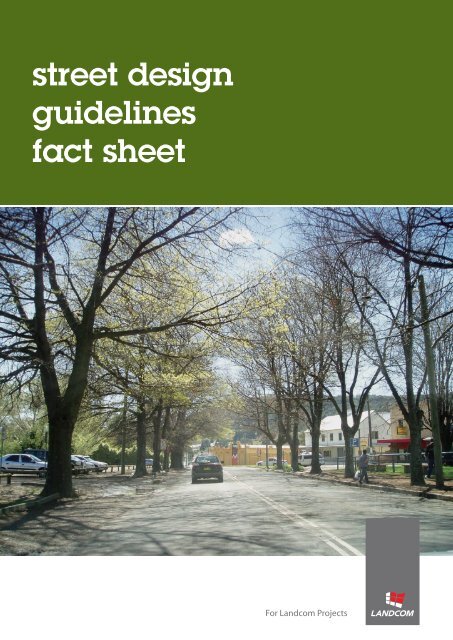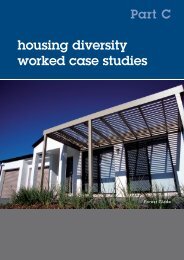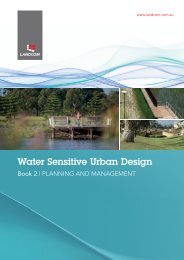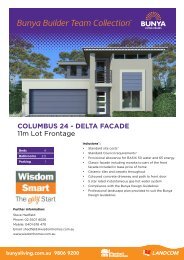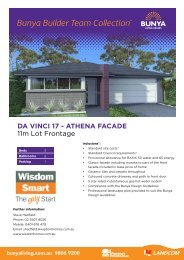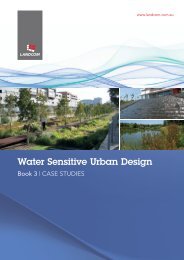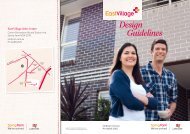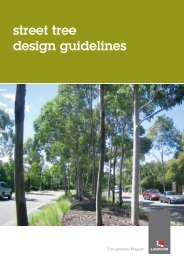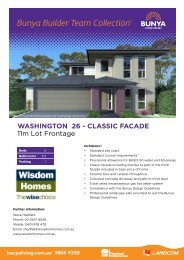street design guidelines fact sheet - Landcom
street design guidelines fact sheet - Landcom
street design guidelines fact sheet - Landcom
Create successful ePaper yourself
Turn your PDF publications into a flip-book with our unique Google optimized e-Paper software.
<strong>street</strong> <strong>design</strong><br />
<strong>guidelines</strong><br />
<strong>fact</strong> <strong>sheet</strong><br />
For <strong>Landcom</strong> Projects
1 | Street Design Guidelines FACT SHEET<br />
Street Design Guidelines<br />
Fact Sheet<br />
Streets perform certain basic functions in the built environment such as providing<br />
routes for vehicles and public transport, and accommodating utility services and<br />
drainage systems. The <strong>design</strong> of a <strong>street</strong> affects how successful it is in performing<br />
these functions, and it can also vitally affect the urban character of a neighbourhood<br />
and influence how people use the <strong>street</strong> and interact with each other on it.<br />
The quality of a <strong>street</strong> and its connections can affect whether people choose to<br />
walk, cycle or take the car. It can affect whether people feel safe.<br />
Its character can influence whether people choose to stroll or hurry through, and<br />
whether they leave their front curtains open during the day or not. The <strong>design</strong> and<br />
layout of <strong>street</strong>s also affects how we experience the natural environment and the<br />
special qualities and quirks of individual places.<br />
About the <strong>guidelines</strong><br />
<strong>Landcom</strong> is committed to best practice urban<br />
<strong>design</strong>. The Street Design Guidelines have been<br />
prepared to promote the <strong>design</strong> of <strong>street</strong>s that<br />
people like: <strong>street</strong>s that make the most of the natural<br />
environment and help to create a sense of place,<br />
while also meeting their functional requirements.<br />
The <strong>guidelines</strong> include <strong>design</strong> principles that should<br />
be applied commonly to all <strong>street</strong> types, as well<br />
as models of the most common <strong>street</strong> types in<br />
<strong>Landcom</strong> developments.<br />
The document is intended to provide a starting<br />
point for the <strong>design</strong> of new <strong>street</strong>s. It provides<br />
<strong>guidelines</strong> for good practice but it is not a code.<br />
Designers will of course have to take into account<br />
the particular constraints and opportunities of<br />
individual sites when applying the principles in this<br />
document. Individual councils and the Roads and<br />
Traffic Authority also have specific requirements to<br />
be taken into account.<br />
The dwellings in this <strong>street</strong> have absorbed the slope<br />
by being <strong>design</strong>ed with the dwellings to have the<br />
garage on the low side of the block and the house<br />
wrapping over the garage.<br />
The Ponds - Float
Street Design Guidelines FACT SHEET | 2<br />
Common <strong>design</strong><br />
principles<br />
The <strong>design</strong> principles are organised by ‘elements’,<br />
however there is some necessary overlap in the<br />
<strong>design</strong> principles for each element. The principles<br />
discussed in the <strong>guidelines</strong> relate to:<br />
1. Connectivity and legibility<br />
2. Intersections<br />
3. Topography and view termination<br />
4. Ease of use<br />
5. Functionality and clarity<br />
6. Safety and vehicle speed<br />
7. Visual containment and continuity<br />
8. Verge <strong>design</strong><br />
9. Landscape <strong>design</strong><br />
10. Water sensitive urban <strong>design</strong><br />
11. Design of on-<strong>street</strong> parking<br />
12. Details and services.<br />
Model <strong>street</strong> types<br />
The <strong>guidelines</strong> include <strong>design</strong> models for:<br />
<br />
<br />
<br />
<br />
<br />
<br />
<br />
<br />
<br />
<br />
At <strong>Landcom</strong>’s Victoria Park the new <strong>street</strong>s are well<br />
connected into those already existing in the area making<br />
the place very permeable to pedestrian, cycle and<br />
vehicular traffic. The functionality of the <strong>street</strong> is clear<br />
with well defined footpaths, parking bays and a two-way<br />
carriageway.<br />
This <strong>street</strong> defines very clearly where each activity is to occur: from walking for pedestrians, to where parking is encouraged<br />
and where the vehicle carriageway occurs. This is an urban solution but the principles are appropriate for any <strong>street</strong>.
3 | Street Design Guidelines FACT SHEET<br />
The simple use of inset pavers within the footpath can<br />
add interest and help to tie in grey driveways through the<br />
estate as part of a coordinated approach.<br />
This <strong>street</strong> has a swale within its central median as part<br />
of the WSUD strategy. The unique kerb treatment and<br />
timber walkway also create an interesting <strong>street</strong>scape.<br />
Victoria Park - Storm Waters<br />
The verge in this <strong>street</strong> is well defined with a strong alignment created by the fence, the simple footpath, grass verge and rain garden<br />
with <strong>street</strong> trees. It creates a pleasant ambiance for pedestrians. Generally the parking bay would not be a different colour to the<br />
roadway as in this image and the cycleway would be combined with one of the <strong>street</strong> footpaths for safety.<br />
Contacts<br />
For further industry enquiries about this guideline contact<br />
Anna Petersen<br />
<br />
apetersen@landcom.nsw.gov.au<br />
02 9841 8652<br />
Steve Driscoll<br />
<strong>Landcom</strong> Director Sustainability & Policy<br />
sdriscoll@landcom.nsw.gov.au<br />
02 9841 8693<br />
For all media enquiries about this guideline contact<br />
Suzanne Davies<br />
<br />
<br />
sdavies@landcom.nsw.gov.au<br />
02 9841 8788 or 0439 439 107


